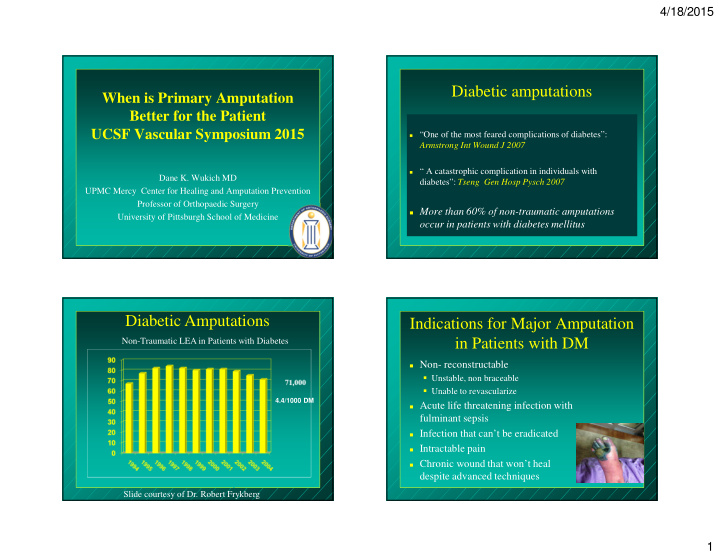



4/18/2015 Diabetic amputations When is Primary Amputation Better for the Patient UCSF Vascular Symposium 2015 � “One of the most feared complications of diabetes”: Armstrong Int Wound J 2007 � “ A catastrophic complication in individuals with Dane K. Wukich MD diabetes”: Tseng Gen Hosp Pysch 2007 UPMC Mercy Center for Healing and Amputation Prevention Professor of Orthopaedic Surgery � More than 60% of non-traumatic amputations University of Pittsburgh School of Medicine occur in patients with diabetes mellitus Diabetic Amputations Indications for Major Amputation in Patients with DM Non-Traumatic LEA in Patients with Diabetes � Non- reconstructable � Unstable, non braceable 71,000 � Unable to revascularize 4.4/1000 DM � Acute life threatening infection with fulminant sepsis � Infection that can’t be eradicated � Intractable pain � Chronic wound that won’t heal despite advanced techniques CDC: Diabetes Surveillance System 2007 Slide courtesy of Dr. Robert Frykberg 1
4/18/2015 Indications for Major Amputation Foot and Ankle Reconstructive in Patients with DM Surgery in Patient with DM � Non- ambulatory patients � High rates of complications � Severe proximal joint contractures � Surgical site infections � Hip and knee flexion contractures � Delayed wound healing � Paraplegia � Nonunion of fusions � Hardware failure � If they could not walk preoperatively unlikely to walk postoperatively unless they have a severe non plantigrade foot that prevents ambulation Why are amputations so bad? 30 Day Perioperative Cardiac Event Anesthesia and Analgesia 2005 (BI Deaconess) Anesthesia and Analgesia 2005 (BI Deaconess) 2
4/18/2015 Long term survival of patients who Is the Amputation Truly the Culprit? undergo AKA or BKA is dismal � 5 yr mortality of diabetic patients undergoing amputation: 47% � 5 yr mortality of patients whose diabetic foot ulcers healed: 44% Moulik et al. Diabetes Care 2003 � Subramanium et al. Anesth Analg 2005 Perhaps it is the patient! Limb Preservation at Georgetown Moulik et al. Diabetes Care 2003 Gazis et al. Diab Med 2004 Evans: J Diab Comp 2011 3
4/18/2015 What Do Our Patients Fear? Diabetic Foot vs. Diabetic Control 5 is greatest fear, 1 least fear Ambulation after Amputation Energy Expenditure � Approximately 65% of patients who undergo BKA will ambulate with a prosthesis � Only 33% of patients who undergo AKA will ambulate with a prosthesis � Why??? 4
4/18/2015 Vascular Amputees Walker Quality of Life Studies Slower than Traumatic Amputees � Suggest that the negative impact on health related QOL in diabetic foot ulcer patients may be as severe or similar to patients who have undergone lower extremity amputation! Willrich et al. FAI 2005 Waters et al. JBJS 1976 Quality of Life Major Amputation and SF 36 DFU versus Amputation (Higher score is better) � No difference between the two groups except that DFU patients had higher bodily pain � Physical limitations were identical between transtibial amputees and DFU patients � Physical limitations were less in minor amputees than DFU patients � Median Scores were quite low for both groups Boutoille et al. FAI 2008 Willrich et al. FAI 2005 5
4/18/2015 No difference in emotional scores � Although amputation remains a drastic step in the story of a DFU, its influence on the quality of life is not between amputation and DFU worse than when the patient suffered from the ulcer � Tennvall and Apelqvist: J Diab Comp 2000 � Peters et al: Diabetes Care 2000 � Willrich et al: FAI 2005 � Boutoille et al: FAI 2008 � Vileikyte: Current Diabetes Reports 2008 Willrich et al. FAI 2005, Boutoille et al. FAI 2008 Study of Transtibial Amputations Outcomes of BKA (32 patients) SF 36 Subscales Preop Mean Postop Mean P value � Minimum one year follow up Physical Function 23.6 47.7 * <0.001 � Mean age 55 years � 32 patients (21 males and 11 females) Role Physical 13.3 40.8 *< 0.001 � Mean duration of diabetes of 20 years Bodily Pain 38.1 63.7 * <0.001 � 85% utilized insulin General Health 41.6 53.9 * <0.05 � Type 1 DM 15% and Type 2 DM 85% Vitality 39.7 51.5 * <0.05 � Self reported outcome instruments were obtained in all Social Function 46.1 75.0 * <0.001 patients pre and postoperatively Role Emotional 33.3 66.2 * <0.01 � SF 36 as a measure of overall health Mental Health 59 71.7 * <0.05 � Foot and Ankle Ability Measure to assess LE function 6
4/18/2015 Patients Overall Health Improved Lower Extremity Function Postop Preop Postop Preop Postop Preop P < 0.001 Preop Conclusion Major Amputation � Amputation is a drastic step in patients with diabetes � Patients fear amputation more than anything except � Well done BKA should not be viewed as a failure blindness � View it as the first step in the patients rehabilitation and � The goal should be the most distal amputation possible that recovery provides stable soft tissue coverage and function � Decreased energy expenditure � Higher likelihood of ambulation 7
4/18/2015 Conclusion Conclusion � If you treat Charcot and/or Diabetic Foot � Mobility in certain patients may be improved with Infections you will have patients who require a a well fitted prosthesis compared to boots, casts major amputation and CROW � In select patients Transtibial Amputation may � Anecdotally I am amazed how much better chronically infected patients feel within 48-72 � Permit faster rehabilitation hours after amputation by eliminating the bacterial � Maintain if not improve quality of life load � Eradicate chronic sources of infection � We do everything possible to avoid a Major � Consult with Physical Medicine and Rehabilation, Amputation Physical Therapy and Prosthetics preop well before the actual BKA 29 30 1920 PITTSBURGH 2014 8
Recommend
More recommend